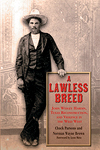A Lawless Breed: John Wesley Hardin, Texas Reconstruction, and Violence in the Wild West, by Chuck Parsons and Norman Wayne Brown, University of North Texas Press, Denton, 2013, $29.95
The first time I heard the irresistibly catchy tune and head-scratching lyrics of Bob Dylan’s “John Wesley Harding,” a one-letter misspelling of one of the American West’s most murderous gunslingers,  I was compelled to ask why. Why did he choose John Wesley Hardin to represent as “a friend to the poor” who “was never known to hurt an honest man”? Aside from there being many more obvious candidates for Robin Hood status in Western mythos, Hardin was hardly in need of a 1960s folk singer to wax rhapsodic over his deeds. In the autobiography he might have started while in prison and then continued afterward in El Paso, the murderer turned lawyer pleaded his own case in the course of chronicling his adventures, justifying his killings as acts of self-defense or perhaps defense of his own honor or that of his native Texas. If one takes his autobiography, Life of John Wesley Hardin, strictly on face value, Wes comes off as the original poster boy for Florida’s “Stand Your Ground” law.
I was compelled to ask why. Why did he choose John Wesley Hardin to represent as “a friend to the poor” who “was never known to hurt an honest man”? Aside from there being many more obvious candidates for Robin Hood status in Western mythos, Hardin was hardly in need of a 1960s folk singer to wax rhapsodic over his deeds. In the autobiography he might have started while in prison and then continued afterward in El Paso, the murderer turned lawyer pleaded his own case in the course of chronicling his adventures, justifying his killings as acts of self-defense or perhaps defense of his own honor or that of his native Texas. If one takes his autobiography, Life of John Wesley Hardin, strictly on face value, Wes comes off as the original poster boy for Florida’s “Stand Your Ground” law.
Since Hardin’s violent death on August 19, 1895, posterity has not been inclined to believe everything it reads in Life of John Wesley Hardin, and the several biographies about him seek corroboration from other contemporary sources, the most outstanding being The Last Gunfighter: John Wesley Hardin, by Richard C. Marohn (1995), and John Wesley Hardin: Dark Angel of Texas, by Leon Metz (1996). In this latest biography, A Lawless Breed, Chuck Parsons and Norman Wayne Brown have gathered an impressive paper trail with which to follow Hardin’s activities from cradle to grave, comparing his version with whatever second, third or fourth opinions they can find to try to document his killings. He probably killed somewhere between 20 and 40 men.
The book may be an embarrassment of riches to the average reader, rendered more ponderous by the occasional repetition of the authors’ points that could have profited from tighter editing. And even with their meticulous research, the exact number of killings attributable to Hardin remains imprecise. Sometimes his memoir described shootings without mentioning whether his target died or survived. In other entries he describes confrontations that never occurred, such as one with Texas-born Bill Longley for which there is no corroborative account besides Hardin’s. Given the sheer quantity of killings on which his notoriety rests, it would have been nice to have an appendix listing and summarizing them to go along with the coverage of each in the book’s narrative.
For those with a fascination for Old West gunmen, and Hardin was indisputably up there with the best (or worst) of those, A Lawless Breed should prove a treasure trove. Authors Parsons and Brown cover not only the life of their ruthless subject but also Hardin’s friends, enemies, acquaintances and victims who turned up along the way, as well as others in the Hardin clan, several of whom led violent lives—and sometimes came to violent ends—of their own. Equally bountiful are the photographs and illustrations, some taken from Hardin’s book, that appear throughout.
Hardin comes across as a man whose sociopathic mindset could thrive amid a violent social environment. The risks were always high, though, and he probably lived as long as he did only because he spent 16 years in prison after his capture in 1877. When he got out, his career change to the legal profession could not save him from a gunnie’s Götterdämmerung, courtesy of Constable John Selman. If Dylan should read this book, he might want to change some of the lyrics of his 1967 song.




